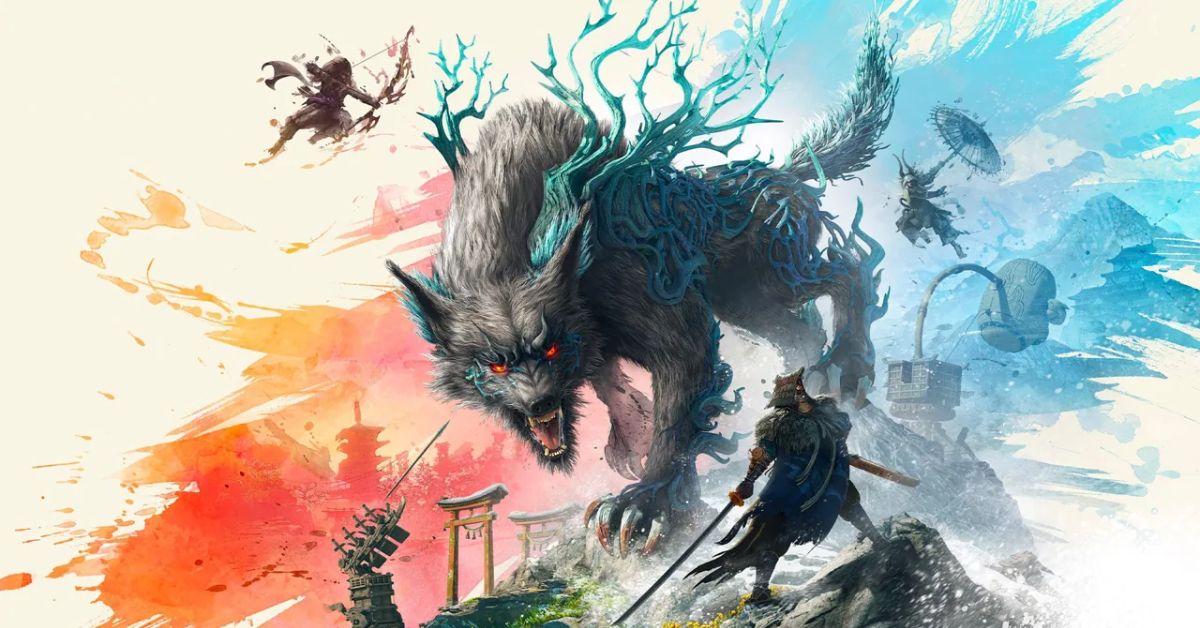Monster Hunter, Capcom’s continuous creature-hunter franchise, has an undeniable cool factor: in our world of banal capitalism, it provides a return to violent, heroic times of yore, where it’s just you, monsters, and a great huge sword. Despite my best efforts, I am unable to answer the call of the hunt without spending hours upon hours reading walls of text and killing the same pathetically small lizards. Before playing Wild Hearts by EA and Omega Force, I decided that games like Monster Hunter weren’t for me.
Set in the bizarre fantasy world of Azuma (influenced by medieval Japan), this project from Fifa’s publisher and Dynasty Warriors’ developers is like a bad dream. Giant mythical beings called Kemono control this world; once placid, they have suddenly turned violent. You’ve been entrusted with resolving the conflict between the towering ruffians and the helpless Azumians.
Wild Hearts manages to feel both enigmatic and approachable in its environment, unlike the game it openly rips off. In contrast to Monster Hunter’s overbearing menus, EA’s version is content to let its magical setting speak for itself. Its huge and overgrown landscape hints at life within a greater civilization as you climb and slash your way through luxurious settings, tempting curiosity in a way that Monster Hunter’s closed-off centers don’t. This is an engaging introduction that speeds you through to the excellent stuff, but then things take a strange turn.
If you’re a gamer and you’re interested in reading some reviews of the other games, you may do so by clicking on the links below:

Wild Hearts flips the bird to Monster Hunter’s gathering-focused gameplay by bestowing upon you the ability to build; this ability, known as Karakuri, entails gathering magical thread that can be used to create fortlike constructions during battle. It’s a hilarious and ridiculous mechanic in which you have access to everything from wooden barricades that deflect enormous tail lashings to a hastily cobbled-together trebuchet hammer.
And it gets funnier: in the middle of the game, while the citizens of the hubworld are being rebuilt, the NPCs claim that they are unable to harness Karakuri, even if there is massive building going on behind them. Who would have thought that a whole video game could pull off a gaslighting? These incongruities are just the beginning of Wild Hearts’ many plot flaws, although the game’s designers do a good job with the creatures themselves and the fighting amongst them.
Wild Hearts’ enemies resemble grotesque versions of legendary Pokémon, in contrast to the more mystical creatures in Capcom’s games. Each ferry-sized monster, from demonic six-eyed boars to spore-coated rodents (including a big flying squirrel that blasts water and shrieks like a dolphin), is hilariously deranged.
As in Destiny before it, the player-driven storylines are far more memorable than the plodding plot; you probably won’t remember the names of any of the non-player characters, but you and your partner will never forget the time you defeated Amaterasu after three failed attempts. Or when you were about to lose the fight but then you built a ludicrous tower in the middle of the assault and miraculously won. To be honest, you’ll want to recruit a pal for this, as playing alone rapidly becomes boring.
If you’re a gamer and you’re interested in reading some reviews of the other games, you may do so by clicking on the links below:
When compared to Monster Hunter’s convoluted matchmaking system, this one makes it a breeze for gamers to team up with familiar faces and complete quests with complete strangers. Upgrade its collection of enticing weapons, including bear claws and a morphing stick, and you’ll finally understand Wild Hearts’ zany mechanics. As you level up, you can expect bigger and flashier encounters, thanks to developer Omega Force’s expertise with the Dynasty Warriors series.
We have embedded the official story trailer for Wild Hearts; if it piques your attention, you can watch it below:
When compared to Monster Hunter, which throws system after system at you and nearly encourages beginners to rage quit, Wild Hearts’ slow approach to delivering its magnificent insanity is a welcome change. One catch, though: you’ll have to return the favor with more patience.
Although the fights are exciting, Wild Hearts constantly takes you out of the experience. Due to a lack of mounts, following your wounded prey on the route to the next battleground will be a slow and exhausting trek. Even more terrible than the actual combat themselves are the tedious dialogues that players are forced to endure in order to return to the wilderness.
The game’s camera is pushed in bizarrely close, and the planet’s characters will have you skipping more than a triple jumper, despite the fact that there is a lot to admire about this setting. This limited perspective can make it difficult to work with these giants, especially in communities with few outsiders.
These aren’t minor complaints, but Wild Hearts is still a lot of fun despite these issues. It’s been thirty hours and I’m still patiently killing monsters in order to unlock the next dazzling weapon and armour set.
The unusual collaboration between Electronic Arts and Omega Force delivers a great hunting experience for newcomers. It’s stupid, it’s imperfect, and it’s probably not destined to be an all-timer, but if you’re in the proper mindset, my god is it fun.
This is the accessible radio single to Monster Hunter’s prog album voyage. To what extent it will continue to sink its claws into me is still to be seen, but after years of being unable to make headway, I finally feel prepared to explore this hitherto inaccessible subgenre.




